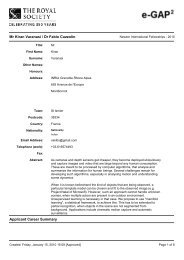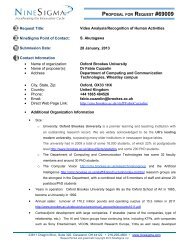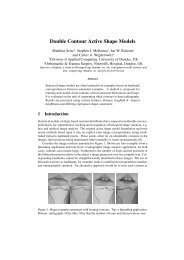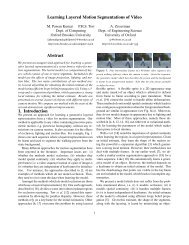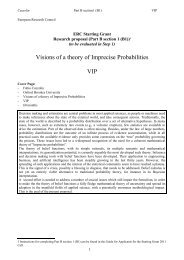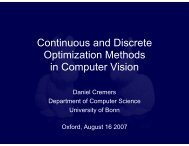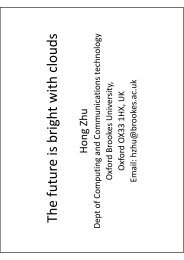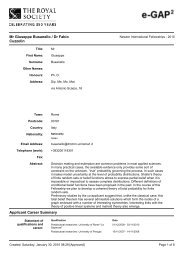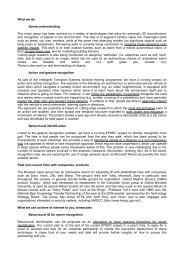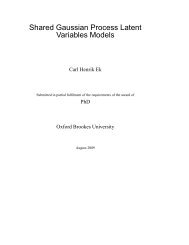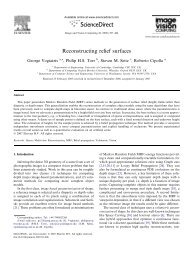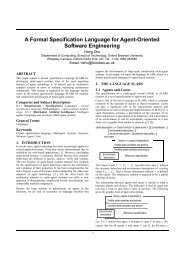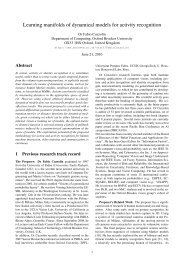Project Proposal (PDF) - Oxford Brookes University
Project Proposal (PDF) - Oxford Brookes University
Project Proposal (PDF) - Oxford Brookes University
Create successful ePaper yourself
Turn your PDF publications into a flip-book with our unique Google optimized e-Paper software.
FP7-ICT-2011-9 STREP proposal<br />
18/01/12 v1 [Dynact]<br />
Bag-of-features (BoF) on spatio-temporal volumes methods. These methods, in which<br />
dictionaries are built from clustering features extracted from (typically) the spatio-temporal volume<br />
associated with a video sequence (Figure 4), have been very successful in recent time. To cite a few, Kim<br />
and Cipolla [32] have proposed a spatio-temporal pattern matching approach in which spatio-temporal<br />
volumes are seen as tensors, and an extension of canonical correlation analysis to tensor analysis is used to<br />
detect actions on a 3D window search. Bregonzio et al [7] have used a global spatio-temporal distribution of<br />
interest points, from which they extract and select “holistic” features over multiple temporal scales.<br />
Rapantzikos et al [44] have also adopted dense spatio-temporal features detected using saliency measures, in<br />
a multi-scale volumetric representation [105]. Yuan at al [60] have described actions, once again, as<br />
collections of spatio-temporal invariant features, and proposed a naive Bayes mutual information<br />
maximisation method for multi-class recognition.<br />
Figure 4. The “baseline”, Bag-of-Feature algorithm for action classification [87].<br />
Issues with BoF methods. These methods have delivered good results in recent years, at least on<br />
datasets of fairly limited size, with few action categories. They have been tested, however, mostly on<br />
classification test-beds with pre-segmented clips, while localization using pure volume descriptors is rather<br />
difficult. It is interesting to note that on a new human motion action dataset dataset with 51 action categories<br />
(HMDB51 [104]), bag-of-features models [87] achieve classification results of just over 20%, suggesting<br />
that these approaches do not fully represent the complexities of human actions. Kuehne et al. has shown that<br />
this drop in performance with respect to previous datasets is most likely due to the increased number of<br />
action categories. [104] has also highlighted the need for more challenging datasets: while in the UCF Sports<br />
dataset [109], human static joint locations alone are sufficient to classify sports actions with an accuracy of<br />
over 98%, the same experiment on HMDB51 performs poorly (35%). This indicates that it may be necessary<br />
to take more into account action dynamics, in accordance with psychophysical experiments in which both<br />
motion and shape are critical for visual recognition of human actions [110, 111]. On top of that, entirely<br />
forgetting the spatio-temporal structure produces paradoxes even in simple mental experiments: by<br />
scrambling around the frames in a spatio-temporal volume we can obtain videos with absolutely no meaning<br />
whatsoever to us, but with roughly the same descriptors as the original one. In fact, the temporal factor is<br />
somewhat implicitly taken into consideration, as descriptors are extracted at multiple space and time scales.<br />
Dynamical generative modelling. Indeed, encoding the dynamics of videos or image sequences can<br />
be useful in situations in which it is critically discriminative. Moreover, actions of sometimes very different<br />
lengths have to be encoded in a homogeneous fashion in order to be compared (“time warping”). Encoding<br />
each video sequence by means of some sort of dynamical generative model has been proven effective when<br />
coping with time warping or temporal segmentation [51]. In these scenarios, action recognition reduces to<br />
classifying dynamical models. Hidden Markov models [23] have been indeed widely employed in action<br />
recognition [43, 51] and gait identification [54, 9]. HMM classification can happen, for instance, by<br />
evaluating the likelihood of a new sequence with respect to the learnt models, or by learning a new model for<br />
the test sequence through the Expectation-Maximisation (EM) algorithm [67], measuring its distance from<br />
the old models, and attributing to it the label of the closest one(s).<br />
Researchers have proposed the use of linear [5], nonlinear [25], stochastic [42, 24] or even chaotic [1]<br />
dynamical systems. Chaudry et al [10], for instance, employ nonlinear dynamical systems (NLDS) to model<br />
times series of histograms of oriented optical flow, measuring distances between NLDS via Cauchy kernels.<br />
As we recalled above, graphical models allow us to address the issue of localization [56], can be used as a<br />
tool to infer “plots” of videos [28] and, in situations in which crowds are present (as in surveillance<br />
scenarios), are suitable to describe the crowd’s behaviour in a way similar to the physical fluids modelling.<br />
<strong>Proposal</strong> Part B: page [9] of [67]



